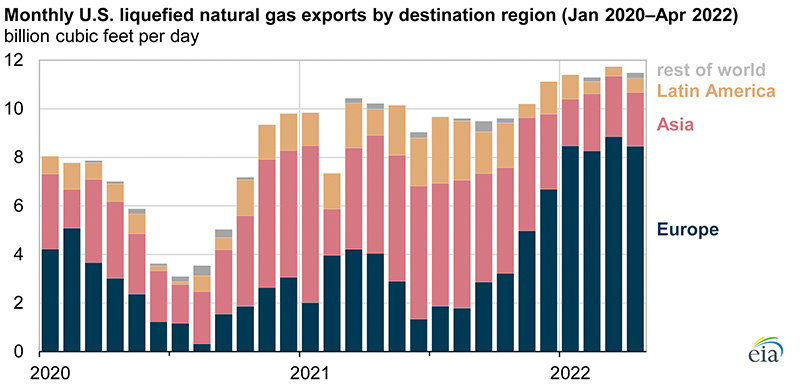October 2022, Vol. 249, No. 10
Features
US LNG Exports to Europe Rise During 2022
(P&GJ) — During the first four months of 2022, the United States exported 74% of its LNG to Europe, compared with an annual average of 34% last year, according to EIA’s Natural Gas Monthly and EIA estimates. In 2020 and 2021, Asia had been the main destination for U.S. LNG exports, accounting for almost half of the total exports.
U.S. LNG exports averaged 11.5 Bcf/d (326 MMcm/d) during the first four months of 2022, an 18% increase compared with the 2021 annual average. Additional export capacity at Sabine Pass (Train 6) and Calcasieu Pass (first five blocks) that came online this year and by high LNG demand, particularly in Europe, drove the increase in U.S. LNG exports.
Since December 2021, the European Union (EU) and the United Kingdom have been importing record-high levels of LNG, primarily because of low natural gas storage inventories.
High spot natural gas prices at the European trading hubs incentivized global LNG market participants with destination flexibility in their contracts to deliver more LNG supplies to Europe. Additional LNG imports in Europe and a mild winter offset lower natural gas pipeline imports from Russia.
The United States became the largest LNG supplier to the EU and United Kingdom in 2021, accounting for 26% of total imports. In the first four months of 2022, LNG imports from the United States to the EU and the United Kingdom have more than tripled, compared with 2021, averaging 7.3 Bcf/d (207 MMcm/d) and accounting for 49% of total imports, according to data from CEDIGAZ. LNG imports from Russia and Qatar accounted for 14% each (2.1 Bcf/d [59 MMcm/d]).
During the first four months of 2022, U.S. LNG exports to Asia declined by 51%, averaging 2.3 Bcf/d (65 MMcm/d) compared with 4.6 Bcf/d (130 MMcm/d) (annual average) in 2021. China and South Korea were top destinations for U.S. LNG exports in 2021.
This year, however, China received only six LNG cargoes from the United States from January through April 2022 (200 MMcf/d [6 MMcm/d], compared with 1.2 Bcf/d [34 MMcm/d] in 2021) because of pandemic-related lockdown measures, a mild winter, high LNG spot prices and reduced demand for spot LNG imports. U.S. LNG exports to South Korea and Japan also declined by 600 and 500 MMcf/d (17 and 14 MMcm/d), respectively.






Comments